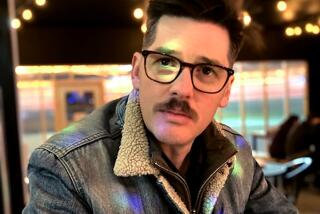A Teller of Tales : As a man who makes his living spinning yarns, Kendall Haven knows how to weave movement and mirth into a learning experience.
- Share via
The students burst into laughter as they watched Kendall Haven tell the tale of a swimmer who barely escaped the jaws of a shark only to remember he had doffed his clothes.
But to prove that what you say isn’t nearly as memorable as how you say it, the award-winning storyteller acted out his story without words.
Haven, 49, used his voice to tell other comical stories to students and teachers at Florence Nightingale Middle School in Cypress Park during a two-day appearance last week.
Through voices ranging from the whine of a somewhat nerdy father to the deep tones of a stern grandmother, Haven transformed a bare auditorium stage into scenes such as a kitchen in Hawaii and a barn in the Irish countryside.
Raised in Glendale, Haven now lives in Santa Rosa but spends more than half his time performing and leading workshops and conferences around the country. After one of the teachers at Florence Nightingale saw Haven perform, he was invited to the school to share his skills with the faculty and students.
*
Thirteen years ago, Haven, then an oceanographer, had little idea that telling stories to his 5-year-old nephew would lead to a new profession.
But his tales started drawing crowds in an Alameda park and earned him invitations to classrooms.
Four books and six audiotapes later, Haven says he is one of more than 100 full-time storytellers in the nation. Among his other honors, his 1994 book, “Marvels of Science,” won the Storytelling World Silver Award. “Stories really belong as a backbone of the way we approach teaching,” he said.
Haven cited research suggesting that students retain images they create while listening to stories better than information presented in reading or through a video. “So when they walk away from stories, the images that get retained are more expansive and more detailed,” he said.
*
While students focus on reading and writing skills, Haven said, workers in the corporate world need to be able to communicate better orally.
Generations raised on television are accustomed to watching what other people have imagined, he said. “What you can visualize is always more exciting. There are no physical limits to what you can imagine.”
Most people have no problem telling stories about themselves when they are in a comfortable situation, Haven tells teachers. But “when we get up to speak in public, we realize that we don’t know how to do what we’re about to do.”
Haven shows teachers how to weave storytelling into the curriculum.
Leading by example, Haven punctuated his mostly original material with vivid body language. He kicked up his feet, cranked his arm, stuck out his tongue and screwed up his face in disgust. He roared, hummed, repeated phrases in a singsong lilt, spoke quickly and loudly, and whispered.
He could tell some students were hooked when he paused slightly before finishing a sentence and they chimed in with the last word.
Between stories, he distilled his message into a three-word definition of a story: characters at war. How the characters react to a struggle over something they care about is what makes a story engaging.
“It was funny,” sixth-grader Joanna Godoy said. She and other students asked for Haven’s autograph.
Gradually, Haven said, writing books will replace his extensive touring. But, he added, “I can’t imagine I’ll ever stop telling stories.”
More to Read
Sign up for our Book Club newsletter
Get the latest news, events and more from the Los Angeles Times Book Club, and help us get L.A. reading and talking.
You may occasionally receive promotional content from the Los Angeles Times.










